Aerial firefighting operators need to respond to the latest advice about monsoon bucket structure and sling line length. Firefighting helicopter significantly damaged in heavy forced landing when tail rotor was disabled by lifting line of underslung collapsible monsoon bucket. Bucket aerodynamics changed when a steel ring holding top mouth open came loose. Hook-and-loop fasteners had come undone.
Executive summary Tuhinga whakarāpopoto
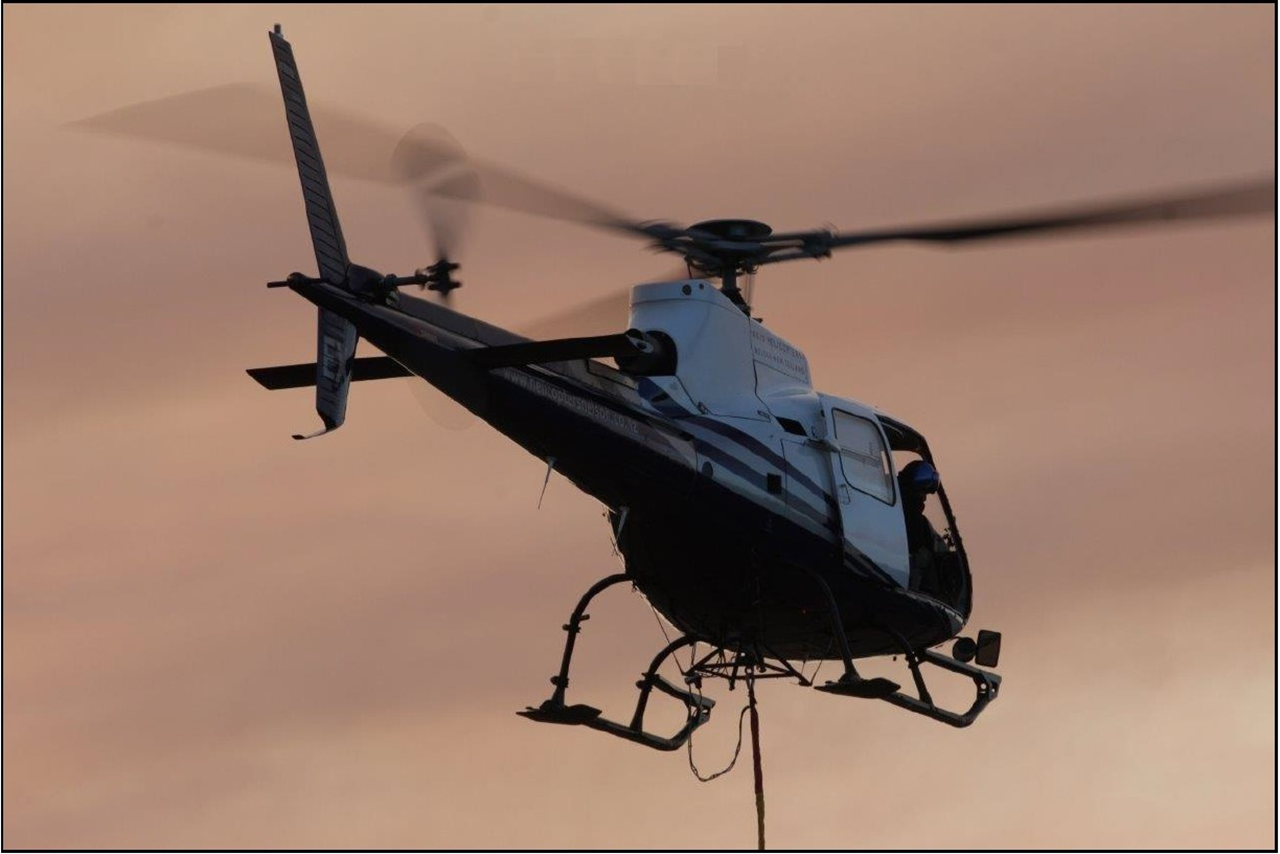
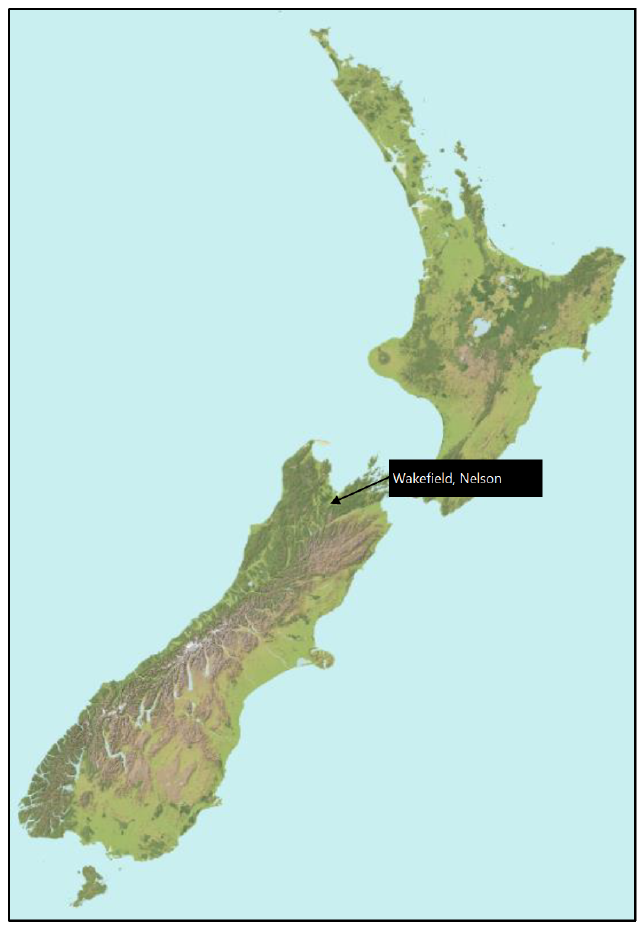
What happened
- On 17 February 2019, an Airbus Helicopters AS350 helicopter, registered ZK-HEX was one of several helicopters assisting with the suppression of forest fires. The fires had been burning throughout the Nelson region over the preceding two weeks.
- The pilot was the sole occupant while the helicopter was operating with an externally suspended monsoon bucket. After dropping a load of water on the target area, the helicopter was returning to a nearby pond to refill the monsoon bucket. The lifting line suspending the monsoon bucket made contact with and disabled the helicopter’s tail rotor, resulting in a loss of directional control. The pilot initiated a descent for a forced landing. The helicopter descended into a forested area and landed heavily, resulting in significant damage. The pilot received minor injuries.
Why it happened
- A tubular, segmented, stainless-steel ring was held in place at the top of the bucket with hook-and-loop fastener tabs. This ring was intended to maintain the circular shape of the top section of the bucket when it was being filled.
- It was likely that during the accident flight, one or more of the hook-and-loop fastener tabs came undone, allowing the ring to become insecure and the bucket to lose rigidity. This likely resulted in a sudden change to the aerodynamic stability of the bucket in the airflow, leading to the bucket trailing behind the helicopter and the lifting line contacting the tail rotor. The reason for the hook-and-loop fastener tabs coming undone could not be determined.
- The bucket manufacturer had developed design improvements to reduce the likelihood of the hook-and-loop fastener tabs coming undone, but the modification was not mandatory. Therefore, the Transport Accident Investigation Commission (Commission) has made a recommendation that the Cloudburst monsoon bucket manufacturer ensure that all Cloudburst monsoon buckets with this hook-and-loop fastener system are modified with the design improvements.
- The monsoon bucket lifting line was of a length that likely increased the risk of the external load coming into contact with the tail rotor. The Commission found that at the time of the accident, there was insufficient guidance available to pilots on the appropriate line length for monsoon bucket operations. The aircraft manufacturer has since published a Safety Information Notice on this issue and the operator has incorporated this guidance into its operating procedures.
What we can learn
- The bucket manufacturer had developed operational information on and limitations for the use of its monsoon buckets, but did not proactively promulgate this information to operators. This omission had the potential for operators to develop policies in isolation, possibly resulting in less-than-optimal safe working practices. As such, the Commission has made a recommendation that the bucket manufacturer review and enhance the Operation Manuals for all Cloudburst buckets to include any recommended operational and maintenance procedures, guidelines and limitations, and promulgate this information to all users of this equipment.
- All occurrences that have safety implications should be reported through the operators’ internal safety management system. The Civil Aviation Authority should also be notified of all occurrences that meet the Civil Aviation Rules Part 12 – Accidents, Incidents, and Statistics criteria. Not reporting a safety-related occurrence is a missed opportunity to prevent a similar occurrence.
Factual information Pārongo pono
Narrative
- On 17 February 2019, the pilot of an Airbus Helicopters AS350 helicopter, registered ZK-HEX (the helicopter), was using a monsoon bucket (the bucket) to drop water on a forest fire in the Wakefield area, near Nelson. The helicopter departed from a staging area at about 1408 (times are in New Zealand daylight time (co-ordinated universal time + 13 hours) and expressed in the 24-hour format) to commence the firefighting task. The pilot was the sole person on board.
- The pilot flew the helicopter in a pattern that involved dipping the bucket, which was suspended from the cargo hook on a lifting line, into a dipping pond then flying with the full bucket to drop the water where required. The helicopter then returned to the dipping pond to repeat the process. Each cycle of dipping, dropping and filling took about three to four minutes.
- At about 1449, the pilot dropped a load of water onto the target area approximately 1.7 nautical miles (one nautical mile equals 1.852 kilometres) from the dipping pond. The pilot then turned the helicopter back toward the dipping pond, while climbing and accelerating.
- The pilot reported that after reaching cruise airspeed, the helicopter unexpectedly yawed violently one way and then the other. The pilot then heard a loud bang and the helicopter commenced an un-commanded turn to the left.
- The pilot initiated a descent for a forced landing, jettisoned the bucket and transmitted a Mayday radio call. The pilot descended towards an area of light bush close to a forest access road, but the helicopter started to spin near the ground. The pilot recalled following the recommended procedure for a loss of tail rotor control by closing the throttle, shutting the engine down to stop the helicopter spinning, and conducting an autorotative landing.
- A number of fire service personnel were working on the ground in the nearby area. They arrived at the accident site within a few minutes and were able to assist the pilot out of the wreckage. The pilot received a minor ankle injury. The helicopter was substantially damaged.
Damage to aircraft
- The helicopter struck the ground heavily with minimal sideways movement. The impact resulted in the separation of the front section of both the left and right landing gear skid tubes, and the deformation of the front section of the cabin structure (Figure 3).
- The main rotor blades were substantially damaged and appeared to have struck the tail boom and surrounding foliage. The rear section of the tail boom and the tail rotor assembly had separated from the main airframe (Figure 4) and landed a few metres to the right of the fuselage.
- One tail rotor blade was broken at its root end but remained attached by its internal structure. The opposing tail rotor blade exhibited no external damage (see Figure 5).
- The two pitch control links on the tail rotor assembly were found deformed (Figure 6) and the tail rotor pitch-control slider had numerous indentations (Figure 7).
- Yellow synthetic material was found on the tail rotor assembly at various locations (Figure 8). The same yellow material was also found on the leading edge of the broken tail rotor blade (Figure 9).
- The tail rotor drive shaft had failed at its forward coupling (Figures 10 and 11).
- The jettisoned bucket was found in a collapsed state in a forested area approximately 100 metres (m) to the south of the helicopter wreckage (Figure 12). A yellow synthetic sheathing was used to enclose the synthetic lifting line, electrical cable and pneumatic line (2.24); all of these exhibited damage at about the same point along the length of line (Figure 13).
- The bucket was inspected in situ. A tubular, segmented, stainless-steel ring normally held in place by hook-and-loop fastener tabs (commonly referred to by the brand name of Velcro®) at the top of the bucket (Figure 14) had come apart and was displaced.
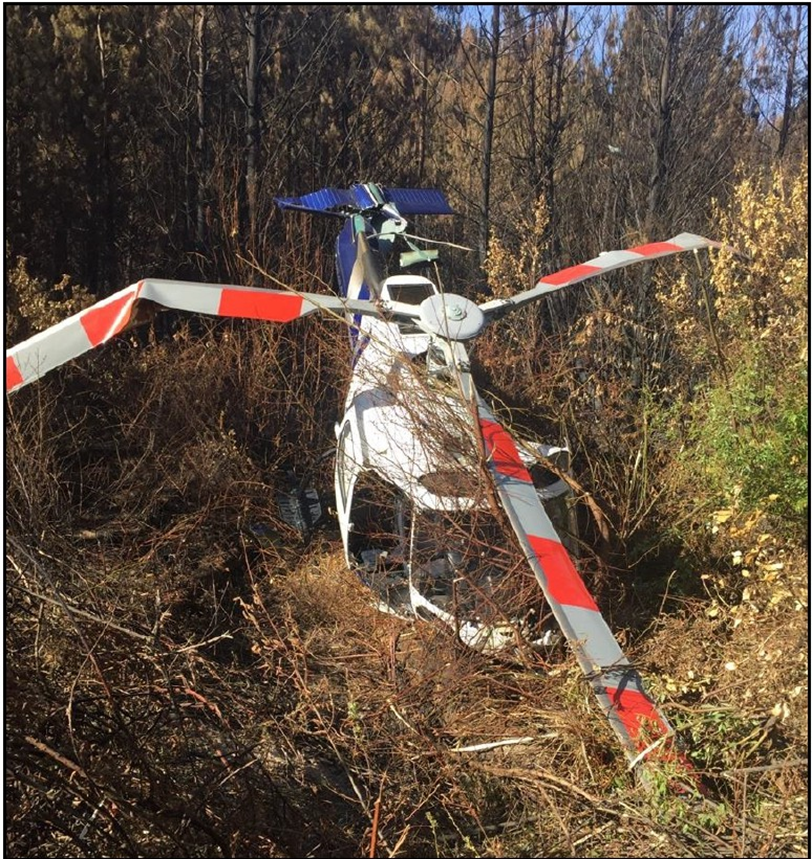
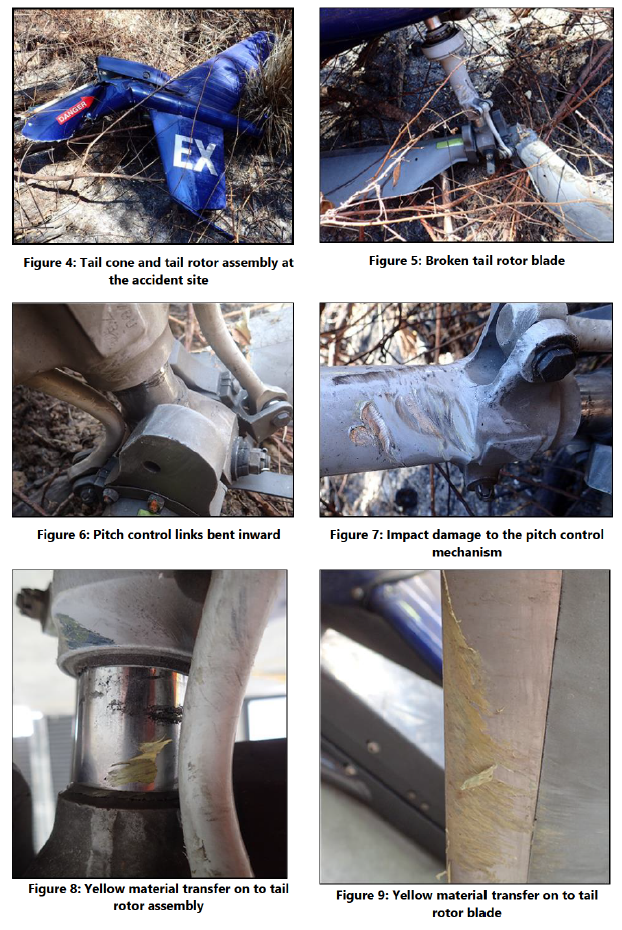
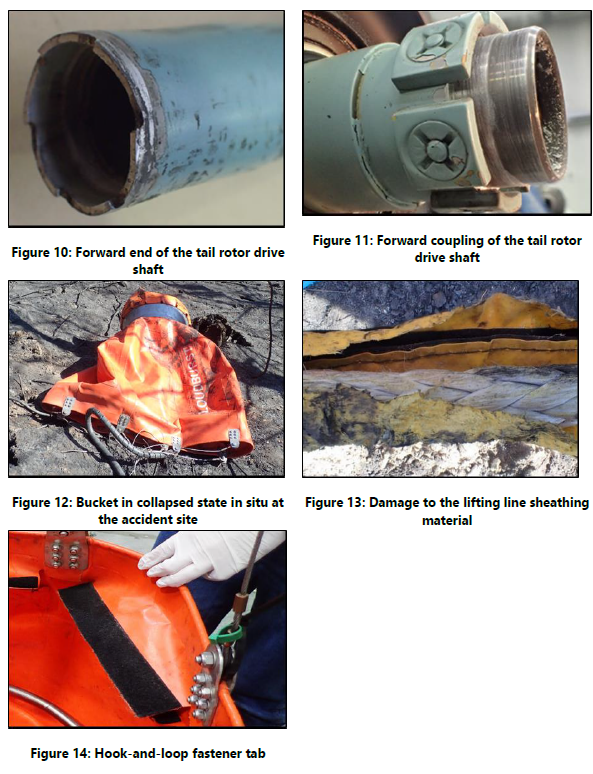
Aircraft information
- The helicopter was constructed in 1982 as a ‘BA’ variant of the AS350 helicopter type. It was later converted to an ‘FX2’ variant. This conversion included, among other things, the replacement of the engine with a Honeywell LTS101 700 D-2, and an increase in the allowable maximum all-up weight limit with an external load, from 2,250 kilograms (kg) to 2,500 kg.
- The helicopter had recorded a total flight time of 5,816.43 hours at the time of the accident. The helicopter had been maintained in accordance with the operator’s approved maintenance programme. The maintenance logbooks showed that all scheduled maintenance had been carried out as required, and the helicopter had no recorded defects at the time of the accident.
- The helicopter was configured to operate with the monsoon bucket suspended from the cargo hook. The right-side pilot’s door had been removed, with the right sliding door locked back in the open position. The left-side sliding door and front doors were both in their closed positions. This configuration was permitted within the helicopter’s flight manual but it reduced the maximum allowable airspeed to 110 knots (the global positioning system and satellite tracking recorded ground speeds of no more than about 80 knots. A knot is a measurement of speed in nautical miles per hour, equivalent to 1.852 kilometres per hour).
Weight and balance
- The helicopter had been fuelled to about 55% of capacity (297 litres) at the start of the fuel cycle. Since then, the helicopter had been flying for about 40 minutes. The pilot estimated that the helicopter had about 40% (216 litres) of fuel remaining at the time of the accident. This equated to about 173 kg.
- The cargo hook beneath the helicopter was equipped with a load cell. This displayed the weight on the hook to the pilot in the cockpit. The pilot stated that the load cell weight was used to determine how much water was in the monsoon bucket during filling and that it was usually filled to about 800 kg.
-
The helicopter’s empty weight was 1,309.95 kg. The maximum allowable all-up weight of the helicopter with an external load was 2,500 kg. The all-up weight of the helicopter was estimated to have remained below this limit throughout the duration of the flight.
- The cargo hook was positioned directly below the main rotor mast. The helicopter’s centre-of-gravity position was within the allowable limits stated in the flight manual with the monsoon bucket both full and empty.
Monsoon bucket and associated lifting line
- The monsoon bucket was an earlier version of the Cloudburst CB1000MF, manufactured in New Zealand by IMS New Zealand Limited (IMS). It had a maximum capacity of 1,000 litres. The bucket was constructed using a flexible urethane fabric.
- The bucket assembly was purchased new by the operator in January 2013 and had been used for 300 hours. It had been maintained in accordance with the operator’s Civil Aviation Authority (CAA) approved internal maintenance programme.
- The synthetic lifting line was 8.5 m in length and attached to the helicopter cargo hook at its upper end and to the bucket control head at its lower end. The synthetic lifting line and associated electrical and pneumatic control lines were wrapped in a yellow, abrasion-resistant synthetic sheathing with a hook-and-loop closure.
- The bucket was suspended below the bucket control head by eight, 3 m-long steel cables (Figure 15). The symmetrical profile of the bucket was maintained by the pressure of the water acting on the inside surface of the bucket (Figure 16) when carrying water and by the tubular, segmented, stainless-steel ring in the upper section of the bucket when empty.
- To fill the bucket with water, the pilot lowered it into a dipping pond. To help the effective filling of the bucket, lead weights were installed on one side, speeding up the submersion and filling process.
- When assembling the bucket for deployment, the eight hook-and-loop fastener tabs (Figure 14) could be opened to accept the tubular, segmented, stainless-steel ring in the upper section of the bucket, then closed to secure it. This allowed disassembly for transport and storage (Figures 18 and 19). The ring had the effect of keeping the top section of the bucket rigid when empty. The operator had kept the bucket in a fully assembled state while in storage to enable rapid deployment.
- A small bladder was attached to the inside wall of the bucket. This bladder could be filled with an additive. Access to fill this bladder was easier with the top ring installed than without. Throughout the operation on the day of the accident, the bladder was filled during every helicopter refuelling cycle. The operator’s ground crew member who had carried out this task stated in the operator’s internal report that the bucket was in good condition during the last refuelling.

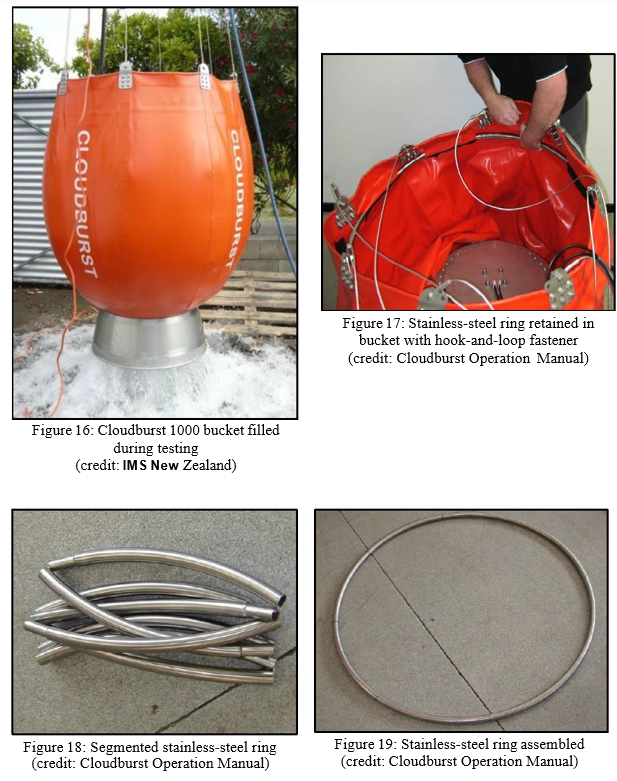
Monsoon bucket certification
- No requirement exists within the Civil Aviation Rules for manufacturers of this type of role equipment (equipment that is fitted to an aircraft to enable it to fulfil a particular mission or task) to be certificated or to produce operational information to assist with the safe operation of their products.
- The onus was on operators to identify risks associated with the use of any role equipment and mitigate those risks appropriately. The CAA’s involvement with such equipment was limited to assessing, and if satisfied approving, an operator’s exposition (documentation approved by the CAA that defined the organisation, identified the senior persons, and detailed the means of compliance with the applicable Civil Aviation Rules), in which maintenance and operating procedures for the use of such role equipment were defined.
Personnel information
- The pilot held a commercial helicopter pilot licence. All required medical and competency assessments were complete and current in accordance with Civil Aviation Rules and the operator’s exposition.
- The pilot had been flying helicopters with monsoon buckets in fire-fighting operations since the mid-1970s. The pilot had received recurrent training for the set-up and use of the monsoon bucket on 15 January 2019. At the completion of that training, the pilot had been authorised by the operations manager to conduct operational roles using the monsoon bucket.
- Drug and alcohol tests were conducted at the hospital after the accident. The results for these tests were negative (clear) for both.
Organisational information
- The operator held an operator’s certificate issued by the CAA under Civil Aviation Rules Part 135 – Air Operations Helicopters and Small Aeroplanes. The operating certificate permitted the operator to conduct commercial external load operations in accordance with its exposition.
Meteorological information
- Weather stations located at Nelson Airport and Richmond, both within eight nautical miles (15 kilometres) to the north-east of the accident site recorded a wind from the north of about 15 knots (30 kilometres per hour), with no significant cloud coverage and at least 19 kilometres of visibility about the time of the accident.
- The accident pilot, as well as another helicopter pilot working in the immediate area, estimated that the conditions at the accident site were similar to those recorded by the weather stations.
Survival aspects
- The helicopter structure was not specifically designed to be energy absorbing in the event of an accident, nor was it equipped with energy attenuating seats. However, most of the impact forces were absorbed by the forward landing gear and cabin support structure, when they deformed, as the helicopter struck the ground vertically.
- The pilot’s seat was equipped with a four-point harness. The pilot advised that the lap belt component of the harness had been secured and the shoulder strap had been positioned beneath the arms to enable sufficient movement to view the external load.
- The pilot was wearing fireproof overalls and a flight helmet as required by the operator’s internal checklist for conducting firefighting operations.
- The helicopter was equipped with an emergency locator transmitter. Impact forces during the accident automatically activated this transmitter. The MEOSAR satellite constellation15 detected and forwarded the transmission to the Rescue Coordination Centre New Zealand. The pilot turned the transmitter off after ground personnel had arrived at the accident site.
Tests and research
- The helicopter was equipped with a global positioning system (GPS) that recorded its flight path, as well as a satellite-tracking device that was configured to transmit flight data every two minutes. The data obtained from both these devices was analysed to determine the helicopter flight profile leading up to and during the accident.
-
An expert metallurgical and chemical analysis of the damage and material transfer observed on the tail rotor assembly was carried out. The report from this analysis concluded:
The samples of the yellow deposit taken from the leading edge of the fractured blade and the yellow sleeve were analysed using Fourier transform infrared (FTIR) spectroscopy. This analysis showed that the FTIR spectra of both samples was very similar, indicating that both samples were the same polyvinyl chloride (PVC) type material.
The evidence shows that the monsoon rope assembly had been caught in the tail rotor assembly when the tail rotor was rotating, and rotation of the rotor/driveshaft stopped abruptly as a result. Debris found on the tail rotor was analysed and found to be the same material as the yellow rope sleeve material. The rope would have very rapidly been tightly wound around the shaft until it bound, when the drive shaft failed. This process resulted in a hard object of some form impacting or embedding into the tail rotor shaft, bending the tail rotor blade control arms and breaking one of the tail-rotor blades.
Additional information
Fire-control activity standards in New Zealand
- In 2015, the National Rural Fire Authority issued the Standard for Use of Aircraft at Wildfires (the original standard). As the National Rural Fire Authority procured the services of aircraft operators for fire-control activities, the original standard was issued with the purpose of facilitating the effective, efficient and safe use of aircraft engaged in these operations. The requirements of the original standard were imposed by the National Rural Fire Authority (as the customer) in addition to Civil Aviation Rules.
- In 2017, New Zealand’s urban and rural fire services combined into a single, integrated fire and emergency service organisation known as Fire and Emergency New Zealand (FENZ). FENZ provided the overarching management of the firefighting resources, which were utilised on this fire, and procured the operator’s helicopter services.
- On 30 August 2017, FENZ updated and issued a new standard, which was active at the time of the accident (Fire and Emergency New Zealand, 2017).
- Since then FENZ has adopted an ‘all-of-government’ approach, which has allowed other New Zealand government agencies to utilise its new standard.
- On 1 May 2020, FENZ further updated the new standard to serve as an interagency standard for the procurement of aircraft to fight wildfires (FENZ has advised that its standard will be publicly available on its website from 1 August 2020: https://fireandemergency.nz).
- The Operational Supplement to the Inter-Agency Standard for Use of Aircraft at Wildfires includes, under Section 23.1 Pilots Using Underslung Loads, the following requirements:
- Operate the helicopter within the flight manual limitations, including limitations relating to configuration and role equipment.
- Only use buckets and related equipment in accordance with the technical requirements, operating instructions and limitations set by the equipment manufacturer and have regard to the effect of the bucket on aircraft performance.
- Ensure the strop length (from the helicopter hook to the bucket attachment cables) is not less than 50ft (15.2 m) for all pilots and all helicopter types.
Operator accreditation
- FENZ stated that to obtain or maintain accreditation, an operator must meet the requirements of the current standard through a verification process and ongoing audit processes. Operators that are unable to conform are subject to a recheck procedure.
- The National Rural Fire Authority had conducted an audit of the operator on 4 May 2017 using the original standard. The operator was subsequently issued with a compliance certificate permitting it to provide helicopter support for fire-suppression operations with the National Rural Fire Authority.
Analysis Tātaritanga
Introduction
- While the helicopter was being flown with an empty monsoon bucket suspended below it, the lifting line struck the helicopter’s tail rotor.
- Helicopter external load operations involve hazards additional to normal helicopter flight. Civil Aviation Rules are in place to minimise these risks by restricting such operations; however, operators are required to identify risks specific to their own operations and mitigate these as much as reasonably practicable. The availability of accurate and relevant information assists operators to make well informed decisions and establish appropriate procedures.
- The following section analyses the circumstances surrounding the event to identify those factors that increased the likelihood of the event occurring or increased the severity of its outcome. It also examines any safety issues that have the potential to adversely affect future operations.
What happened
- The pilot stated that while dipping the bucket normally into the dipping pond immediately before the accident the bucket “looked soft” and did not fill correctly. A second attempt was made to lower the bucket into the water, after which, the pilot observed, a weight of 800 kg displayed on the load cell. This confirmed to the pilot that the bucket was filled sufficiently. The pilot recalled the shape of the bucket looking normal and then continuing with the flight as intended.
- The pilot flew to the target area with no noticeable problems, then dropped the load of water on the target area as planned. A climbing turn was commenced towards the dipping pond with the empty bucket.
- During this flight back to the dipping pond, the synthetic lifting line for the bucket contacted the tail rotor, resulting in the failure of the tail rotor and the drive shaft. This was evidenced by:
- fire service personnel and another helicopter pilot stating that they saw the monsoon bucket in close proximity to the tail rotor, followed by the helicopter turning to the left
- the pilot’s recollection of the accident sequence
- damage to the tail rotor assembly and the nature of the failure of the tail rotor drive shaft
- the chemical analysis of the material transferred onto the tail rotor assembly, which confirmed that it was the same as the lifting line sheathing.
- With the tail rotor disabled, the pilot was not able to maintain directional control of the helicopter and had to descend into the forested area below to conduct a forced landing.
Why it happened
- A number of factors that could have caused the contact between the lifting line and the tail rotor were considered, including:
- environmental conditions/turbulence
- the flight regime, i.e. control inputs/airspeed
- mechanical failure
- the bucket’s aerodynamic stability.
- The environmental conditions at the time of the accident were reported as good, with nearby weather stations recording about 15 knots of wind.
- A BK117 helicopter (the BK117 was a light twin-engine helicopter) was operating in the same circuit pattern as the accident helicopter. The pilot of that helicopter and the accident pilot had both completed numerous water drops within the circuit and had not experienced any adverse wind conditions or significant turbulence.
- At the start of the accident sequence, the GPS recorded a ground speed of about 70 knots. The GPS data also showed a consistent and predictable flight path throughout the 40-minute flight, with the ground speed under 80 knots. No unpredictable flight characteristics from the bucket were reported when flown at 70 knots airspeed.
- The environmental conditions that existed at the time of the accident, excessive control inputs, excessive speed and any technical/mechanical issues with the helicopter were all eliminated as possible contributing factors by the evidence. Therefore, the investigation focused on the aerodynamic stability of the bucket, which likely resulted in the contact with the tail rotor.
The monsoon bucket’s aerodynamic stability
Safety issue: the initial design of the Cloudburst monsoon bucket meant the hook-and-loop fastener system had the potential to come undone during operations
- As the size, shape and weight of underslung loads vary significantly, so does the potential for a load to become aerodynamically unstable. The airspeed of the helicopter also affects the amount of aerodynamic force generated by the load. A higher airspeed will result in larger forces, and a lower airspeed will result in lower forces. The Commission was made aware of previous occurrences of this type of bucket becoming unstable in flight and examined these occurrences to establish if any similarities existed.
Previous occurrences
- The operator’s manager of operations recalled an earlier incident involving the same bucket used on the accident flight, when they were gaining their initial experience with it. In that earlier incident the bucket had become aerodynamically unstable as the helicopter gained airspeed, and the bucket had “started to sail”. The pilot had landed and found that the bucket’s top ring had not been installed correctly. After reinstalling the top ring, the pilot had been able to continue without further incident.
- The Commission received reports from other operators that used this version of the Cloudburst monsoon bucket. One pilot reported being unable to fill the bucket correctly when dipping into the sea. That pilot noted that two of the hook-and-loop fastener tabs had opened. While the ring had remained in place, the fabric of the bucket had no longer been able to maintain its circular shape. The pilot had dumped all remaining water from the bucket and returned to the staging area. The pilot reported that the bucket had been ”misbehaving” and it could not be flown fast. The short flight back to the staging area had been conducted just above translational speed.
- A pilot of a third operator also described the bucket not flying correctly due to hook-and-loop fastener tabs opening on at least two occasions.
- Similarities existed between the other pilots’ observations and the accident pilot’s description of the bucket “looking soft” while filling. Therefore, the investigation sought to understand the bucket’s hook-and-loop fastener system.
Hook-and-loop fastener
- The jettisoned bucket was recovered from a forested area at a location approximately 100 m from where the helicopter came to rest. The initial examination of the bucket found that a number of the hook-and-loop fastener tabs had been displaced, the tubular, segmented, stainless-steel ring was no longer in place, and the top of the bucket had collapsed (Figure 12).
- The top section of the lifting line was suspended in a tree and it appeared to have struck tree branches as it fell. One of the hook-and-loop fastener tabs appeared worn when compared to the other tabs. This particular tab was located below the weighted edge, which was at the front of the bucket in normal flight.
- A post-accident examination conducted by the Commission with the assistance of the manufacturer determined that while one of the hook-and-loop fasteners appeared worn, it was capable of supporting the forces expected when filled with water. However, this did not consider the additional aerodynamic loads experienced by the bucket in flight.
- Videos of various Cloudburst buckets in flight were reviewed. It could be seen that when flown empty with the stainless-steel ring secure and in place, the forward surface of the bucket exposed to the airflow was deflected inward by the pressure of the air impinging on the front of the bucket, but it remained stable in flight.
- The combined effects of the fabric deflecting in flight and the flexing of the weighted edge when dipping could have resulted in forces pulling in opposing directions on the hook-and-loop fastener tabs at the front of the bucket. This action, combined with the compromised integrity of the worn hook-and-loop fastener tab, may have resulted in the forward tabs coming undone and the stainless-steel ring becoming dislodged.
- Due to the lack of clear evidence to explain the displaced hook-and-loop fastener, the Commission was unable to determine whether the displaced hook-and-loop fasteners were due to incorrect installation, worn material and flight loads, abnormal forces during firefighting activities such as striking a submerged object during dipping, or a combination of these.
- While the Commission was unable to determine what initiated the displacement of the hook-and-loop fastener, its displacement likely resulted in the stainless-steel ring becoming dislodged, which allowed the soft fabric of the empty bucket to collapse and change the shape of the front and top of the bucket. The airflow from forward flight acting on the misshapen and collapsed bucket resulted in the bucket becoming aerodynamically unstable and flying significantly higher and closer to the helicopter.
Bucket design evolution
- Since the Cloudburst monsoon bucket’s initial design, a number of improvements have been incorporated into the bucket’s various components. The early design of the hook-and-loop fastener tabs to retain the tubular, segmented, stainless-steel ring was superseded. The new design was for the ring to be made out of a rigid composite material, in two sections, and for it to be permanently bolted into the bucket.
- IMS advised that the change in design of the top ring enabled the bucket to be more rapidly deployed on site, and the design was not changed because of any safety concerns. IMS advised the Commission that some operators of the earlier-designed bucket had been told that, if they had concerns, they or IMS could carry out a modification to install the top ring in the bucket permanently by stitching the hook-and-loop fastener tabs together.
- Monsoon buckets used for firefighting operations are inherently exposed to harsh operating conditions, where submerged objects or waves may impart forces on the hook-and-loop fasteners. This creates the potential for hook-and-loop fasteners to come undone during operations, as evidenced by the previous occurrences and this accident. Therefore, the Commission has made a recommendation to the manufacturer that all Cloudburst monsoon buckets be fitted with the new design.
- IMS advised the Commission that it had produced 128 buckets with the earlier tubular, segmented, stainless-steel ring. Of these, 33 had been sold in New Zealand. As this equipment had not been controlled or tracked after the initial sale, the status of these earlier buckets could not be determined.
Operational procedures
Safety issue: The manufacturer of the Cloudburst monsoon bucket had not promulgated key operational information on and limitations of the Cloudburst monsoon bucket to operators.
Safety issue: There was insufficient guidance to pilots on the appropriate line length for monsoon bucket operations.
- External loads carried by helicopters have the potential to become unstable in flight. This is a risk that operators normally manage by developing standard operating procedures applicable to each role.
- The availability of information about safe working practices, developed by subject-matter experts such as bucket manufacturers and technical specialists in the field, assists operators to make well informed decisions and establish good procedures. When the relevant guidance is not available, operators may revert instead to personal knowledge and experience to formulate their procedures.
- IMS had developed recommended limitations regarding airspeed, line length, and empty bucket flight configuration for the Cloudburst monsoon bucket and had also published an ’Operation Manual‘. This manual provided descriptions of the bucket’s components, but contained no information relating to the aforementioned limitations.
- As the aviation regulatory framework did not cover this type of external load equipment, there was no requirement for a manufacturer to promulgate any operational information or limitations, and IMS had not done so. By comparison, the Commission found that a Canadian manufacturer of a similar product, known as a ‘Bambi Bucket’, had produced detailed operational and service manuals that were accessible to operators (see Appendices 1 and 2 for relevant extract from the Operations Manual).
- When conducting external load operations, a pilot has to decide on the length of the lifting line for the underslung load. The use of a longer lifting line between the helicopter and the underslung load being carried increases the distance that the underslung load needs to move upwards before the lifting line contacts any part of the helicopter. This reduces the likelihood of such contact occurring and increases the time that the pilot has to respond. A shorter line tends to increase the accuracy and efficiency of the operation.
- Section 3 of the Bambi Bucket Operations Manual described a procedure for checking tail rotor clearance when using a line length of less than 15 m. The full procedure is included in Appendix 1 of this report. It is summarised below:
- measure the distance from the cargo hook to the closest point of the helicopter tail rotor
- determine the bucket overall length – including the suspension cables, from the shackle on the head to the lowest point of the bucket
- the tail rotor clearance must be a minimum of 0.15 m.
- In June 2019 Airbus Helicopters issued Safety Information Notice No. 3349-S-25 – ‘Follow-up of recommendations and limitations associated with the use of bucket-type fire-fighting systems’ (see Appendix 3). This notice defined the importance of following manufacturers’ recommendations, reiterated the procedure contained in the Bambi Bucket Operations Manual and expanded its scope to cover all bucket-type suspended systems used for firefighting.
-
In summary, this procedure recommended using either a short lifting line configuration that ensured no part of the bucket could ever be closer than 0.15 m from the tail rotor, or a long lifting line of no less than 15 m in length.
- The Commission found that some jurisdictions defined specific operational and equipment requirements for the procurement of helicopter firefighting operations. In the United States for example, the National Wildfire Coordinating Group Standards for Helicopter Operations required lifting lines to be 50 feet (15.2 m) or longer.
- The FENZ standard in place at the time of the accident did not have a requirement for lifting line length at the time of the accident. The only reference to lifting line length was that “Strop length shall be optimised with the type of bucket to counter rotor wash on the fire” (Fire and Emergency New Zealand. Standard for Use of Aircraft at Wildfires. Equipment Section 24, Para 24.1).
- The lifting line used on the accident flight was 8.5 m in length. The Commission identified that three additional accidents had occurred, in New Zealand, Italy and France respectively, involving fire buckets contacting the tail rotors of AS350 helicopters (Sainte-Rose, France, 24 January 2019, AS350-B3e, registered F-OFML (Bureau d’Enquêtes et d’Analyses pour la Sécurité de l'Aviation Civile Final Report, BEA2019-0023); Sardinia, Italy, 21 August 2015, AS350 registered I-GBVD; Christchurch, New Zealand, 14 February 2017, AS350 registered ZK-HKW (Commission inquiry AO-2017-001)). All four of these helicopters were configured with lifting line lengths placing the buckets within the recommended ‘no-go’ zone as defined by the Bambi Bucket Operations Manual and the Airbus Safety Information Notice.
- There have been no recorded accidents involving a fire bucket contacting the tail rotor of a helicopter when configured with the recommended length of lifting line.
- The Commission is therefore of the opinion that the recommended limitations for tail rotor clearance, such as described in the Bambi Bucket Operations Manual and the Airbus Safety Information Notice, should be applied to all monsoon buckets.
- At the time of the accident the operator’s procedures did not specify the appropriate line length for monsoon bucket operations. It is noted, however, that the Airbus Safety Information Notice was not published until after the accident. The operator has since incorporated the Airbus guidance into its operating procedures and FENZ has included a similar requirement in its updated supplement for wildfire operations.
Other considerations
Comparison with previous accident (Commission inquiry AO-2017-001)
- In another similar accident, which occurred in New Zealand in 2017 and was the subject of a Commission inquiry (AO-2017-001), there were common factors involved with lifting-line length.
- The similarities between the two accidents were: a) each involved a Cloudburst bucket where the rigging contacted the tail rotor of an AS350 helicopter; and b) each bucket was equipped with a lifting line of a length that increased the likelihood of that contact happening. However, the likely initiating cause of the contact between the tail rotor and the bucket rigging differed between the two accidents.
- The helicopter involved in the earlier accident in New Zealand had been equipped with a camera, which had recorded video of the bucket throughout the flight. This video evidence did not reveal any evidence of anomalies with the Cloudburst bucket’s tubular segmented steel top ring, or its hook-and-loop fastener retaining system.
Notification of occurrences and reporting
- The operator had not reported their earlier incident with this same bucket (see 3.14) through their internal quality and safety management system. As a result, that incident had not been advised to the CAA or used internally to promote awareness or improve operational procedures.
- The operations manager advised that since the earlier occurrence the operator’s safety management system had evolved and that such an occurrence would now be captured and actioned appropriately.
- During a separate Commission inquiry into an accident involving a different operator (Christchurch, New Zealand, 14 February 2017, AS350 registered ZK-HKW (Commission inquiry AO-2017-001)), the Commission had determined that an occurrence that related to the likely cause of that accident had not been notified either internally in the operator’s systems or through the CAA reporting system. That omission had also resulted in a lost opportunity to share experiences and learnings and potentially prevent a reoccurrence.
- While Civil Aviation Rules Part 12 – Accidents, Incidents, and Statistics defined the requirements to notify the CAA of accidents and certain incidents, the reporting of all occurrences through an operator’s internal safety management system should be encouraged.
- On 6 April 2020 IMS issued on its website a Service Information Letter detailing a pre-flight checklist for the Cloudburst bucket with the tubular, segmented, stainless-steel ring and the Velcro retention tabs.
- The Service Information Letter followed an email sent to a mailing list from IMS on 7 February 2020, which included a Cloudburst Fire Bucket Safety Notice. This notice explained that IMS had discovered worn Velcro retention tabs during maintenance and therefore wished to highlight the importance of equipment checks and maintenance to operators of the buckets.
- On 19 May 2020 the CAA made a submission to the Commission in response to receiving a draft copy of this report. The submission outlined that the CAA had issued Continuing Airworthiness Notice 05-012 on 16 April 2020. The Continuing Airworthiness Notice outlined that the CAA strongly recommended that operators and maintainers follow the instructions in the Cloudburst Fire Bucket Service Information Letter, dated 6 April 2020 issued by IMS.
Additional information
- During this inquiry the Commission learned that the CAA was in the process of developing an advisory circular to Civil Aviation Rules Part 133 – Helicopter External Load Operations. This advisory circular was intended to provide additional information pertinent to the equipment and the conduct of helicopter external-load operations. At the time of writing this report, the specific content of the advisory circular was not available to review as it was still in an early draft phase.
- In November 2019 the CAA, in conjunction with a commercial supplier of lifting equipment, carried out a number of educational workshops for helicopter operators on how to inspect and safely use lifting equipment.
- Both of these programmes were in development prior to this accident, and were initiated due to an industry-wide recent increase in helicopter external-load incidents.
Findings Ngā kitenga
- The lifting line contacted and disabled the tail rotor while the helicopter was in forward flight.
- It is likely that one or more hook-and-loop fastener tabs holding the tubular, segmented, stainless-steel in place in the monsoon bucket came undone and the bucket ring became displaced.
- The reason for the hook-and-loop fastener tabs becoming undone could not be determined.
- The displaced tubular, segmented, stainless-steel ring very likely allowed the shape of the bucket to change in the airflow, resulting in the bucket suddenly moving into close proximity to the helicopter and the underslung load lifting line, then striking the tail rotor.
- The monsoon bucket had a hook-and-loop fastener system that had the potential to come undone during operations. The bucket manufacturer had developed design improvements to reduce the likelihood of the hook-and-loop fastener tabs coming undone, but these modifications were not mandatory.
- The bucket manufacturer had developed operational information and limitations for the use of its monsoon buckets, but did not proactively promulgate this information to operators.
- The monsoon bucket lifting line was of a length that likely increased the risk of the external load coming into contact with the tail rotor.
- There was insufficient guidance available to pilots on the appropriate line length for monsoon bucket operations.
Safety issues and remedial action Ngā take haumanu me ngā mahi whakatika
General
- Safety issues are an output from the Commission’s analysis. They typically describe a system problem that has the potential to adversely affect future operations on a wide scale.
- Safety issues may be addressed by safety actions taken by a participant, otherwise the Commission may issue a recommendation to address the issue.
Design of the hook-and-loop fastener on Cloudburst monsoon buckets
- Monsoon buckets used for firefighting operations are inherently exposed to harsh operating conditions, where submerged objects or waves may impart forces on them. This creates the potential for hook-and-loop fasteners used on the Cloudburst monsoon buckets to come undone during operations. This was evidenced by previous occurrences and this accident.
- The manufacturer has progressively modified the Cloudburst bucket design, which has removed this risk in newer versions. However, IMS advised the Commission that it had produced 128 buckets with the earlier tubular, segmented stainless-steel ring. Of these, 33 had been sold in New Zealand. As this equipment was not controlled or tracked after the initial sale, the status of these earlier buckets could not be determined. Therefore, the Commission has made a recommendation.
- No action has been taken to address this safety issue. Therefore, the Commission has made a recommendation in Section 6 to address this issue.
Promulgation of operational information and limitations of Cloudburst monsoon buckets
- Where manufacturers have information about the safe operation of an item of equipment used in a safety-critical role, but do not make this information readily accessible, operators may develop policies in isolation, possibly resulting in less-than-optimal safe working practices.
- No action has been taken to address this safety issue. Therefore, the Commission has made a recommendation in Section 6 to address this issue.
Insufficient guidance to pilots on the appropriate line length for monsoon bucket operations
- At the time of the accident there was insufficient guidance available to pilots on the appropriate line length for monsoon bucket operations. This increased the risk of an incorrect line length being used and aerodynamically unstable loads contacting the tail rotor.
- Airbus Safety Information Notice No. 3349-S-25, which provides guidance on this issue, was published after the accident. The operator has incorporated this guidance into its operating procedures. The Commission considers this safety action to be appropriate, and has not made a recommendation.
Recommendations Ngā tūtohutanga
General
- The Commission issues recommendations to address safety issues found in its investigations. Recommendations may be addressed to organisations or people, and can relate to safety issues found within an organisation or within the wider transport system that have the potential to contribute to future transport accidents and incidents.
- In the interests of transport safety, it is important that these recommendations are implemented without delay to help prevent similar accidents or incidents occurring in the future.
- In this case, recommendations have been issued to IMS, with notice of the recommendations given to the CAA.
New recommendations
- On 25 June 2020 the Commission recommended that IMS New Zealand Limited review and enhance the Operation Manuals for all Cloudburst buckets to include any recommended operational and maintenance procedures, guidelines and limitations, and develop a current register of users and actively disseminate this information to them. (007/20)
-
On 25 June 2020 the Commission recommended that the Managing Director of IMS New Zealand ensure that all Cloudburst monsoon buckets with hook-and-loop fasteners are modified to incorporate improvements in the fastener design. (008/20)
On 14 July 2020, IMS New Zealand replied:
Our actions have been:
- Detailed manuals of operation and safety of the Cloudburst Fire Buckets has been significantly evolved since the hook and loop style Cloudburst [sic]. These will continue to evolve with the product development.
- We have sent out a Safety Information Notice to all the email addresses we have available ... (see Appendix 5).
- Also we have now included in our manual a owners [sic] register to aid the tracking of the ownership on any of our Cloudburst Fire Buckets.
Key lessons Ngā akoranga matua
- The notification and reporting of all safety-related occurrences by aircraft operators, both internally and externally, presents an opportunity for the sharing of safety lessons, therefore preventing reoccurrences.
Data summary Whakarāpopoto raraunga
Details
latitude: 41° 19’ 60” S
longitude: 173° 02’ 42” E
Conduct of inquiry He tikanga rapunga
- On 17 February 2019 the CAA notified the Commission of the occurrence. The Commission subsequently opened an inquiry under section 13(1) of the Transport Accident Investigation Commission Act 1990 and appointed an investigator in charge.
- In accordance with Annex 13 to the Convention on International Civil Aviation, the Commission notified the aircraft state of manufacture, the Bureau d’Enquêtes et d’Analyses of France (BEA), and the engine state of manufacture, the National Transportation Safety Board of the United States. On 18 February 2019 the BEA appointed an accredited representative for France and appointed Airbus Helicopters as its technical adviser.
- On 18 February 2019 Commission investigators travelled to Nelson. They received briefings from the fire service and the police before continuing to the operator’s base to conduct interviews with the pilot in command and the operations manager.
- On 19 February a site investigation was conducted and the helicopter wreckage was recovered from the site on the same day. On 20 February the helicopter wreckage was relocated to the Commission secure facility in the Wellington region.
- On 28 February the Commission investigators travelled to the monsoon bucket manufacturer’s facility to conduct interviews and gather more information about the Cloudburst monsoon bucket.
- On 7 May 2019 a principal consultant metallurgist from Quest Integrity Group NZL Limited conducted an examination of the damaged tail rotor assembly. Replicas of the damage were made for further laboratory analysis, and samples of the transferred material were provided to Callaghan Innovation to conduct a Fourier transform infrared analysis. On 4 June 2019 Commission investigators received a report detailing the results of these analyses.
- On 14 April 2020 the Commission approved a draft report for circulation to six interested persons for their comment.
- The Commission received four submissions, and changes as a result of these have been included in the final report.
- On 24 June 2020 the Commission approved the final report for publication.
Glossary Kuputaka
- Flight manual
- A controlled document kept in the cockpit that provides information about the aircraft, including system descriptions, limitations and normal and emergency procedures.
- Knot
- A measurement of speed in nautical miles per hour, equivalent to 1.85 km/h.
- Monsoon bucket
- A generic term to describe a bucket suspended beneath a helicopter, intended to carry and drop water as required. A vast number of different designs are utilised globally
- Nautical miles
- 1 nautical mile (NM) equals 1.85 kilometres (km)
Citations Ngā tohutoru
Airbus Helicopters. (2019). Safety Information Notice No. 3349-S-25 Follow-up of recommendations and limitations associated with the use of bucket-type fire-fighting systems.
CAA. (2020) Continuing Airworthiness Notice – 05-012.
Fire and Emergency New Zealand. (2017). Standard for Use of Aircraft at Wildfires. IMS New Zealand Limited. (n.d.). Cloudburst Fire Bucket Operation Manual.
IMS New Zealand Limited. (2020) Safety Information Letter 6 April 2020.
National Wildfire Coordinating Group (USA). (2019). NWCG Standards for Helicopter Operations.
SEI Industries Limited. (2019). Bambi Bucket Operations Manual 2019A. Transport Accident Investigation Commission. (2018). Final Report AO-2017-001.
Transport Accident Investigation Commission. (2018). Interim Report AO-2018-009.
Appendix 1. Bambi Bucket tail rotor clearance
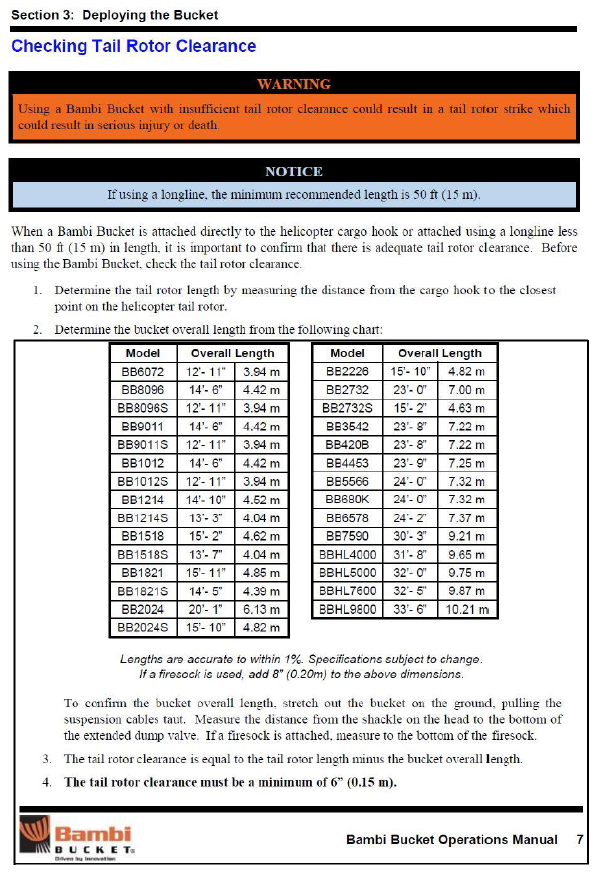
Appendix 2. Bambi Bucket flight operations
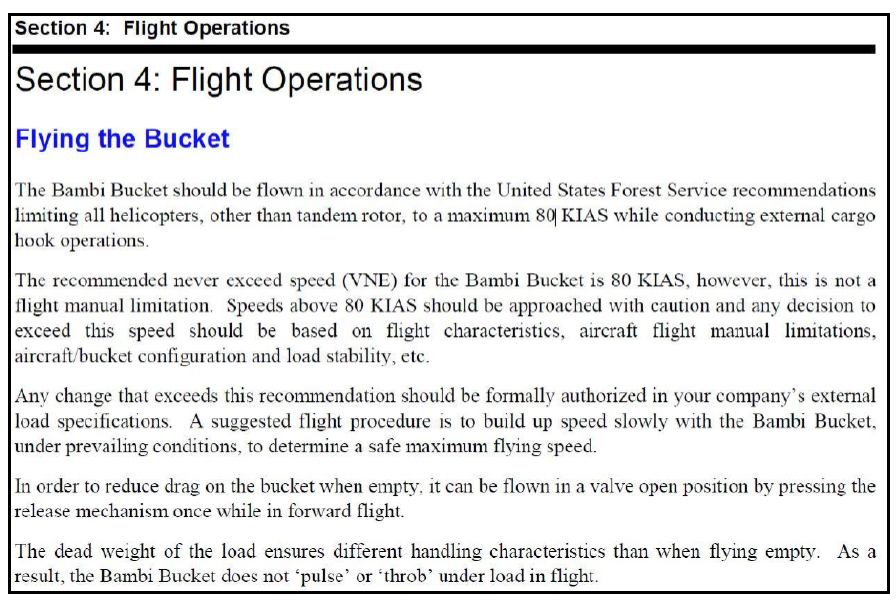
Appendix 3. Airbus Helicopters Safety Information Notice
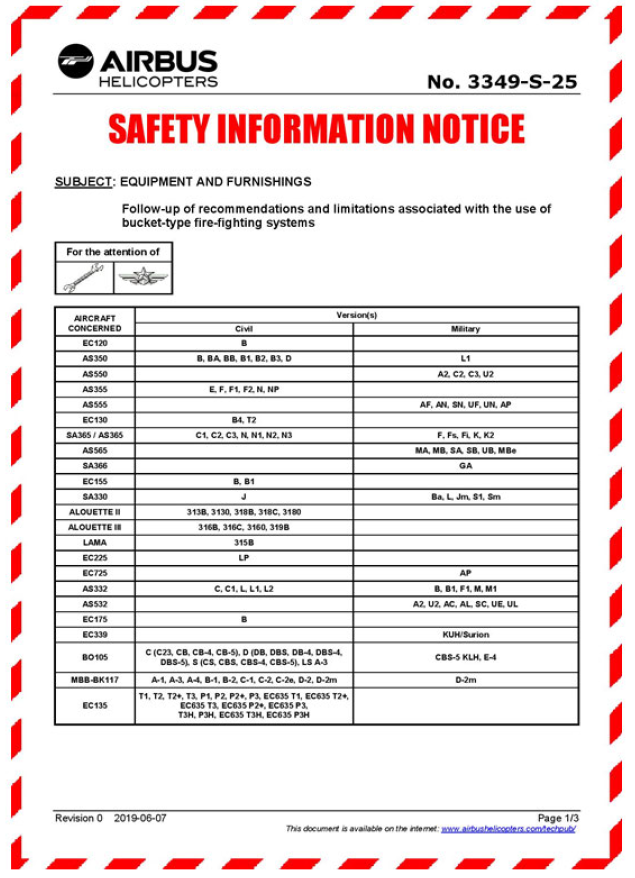
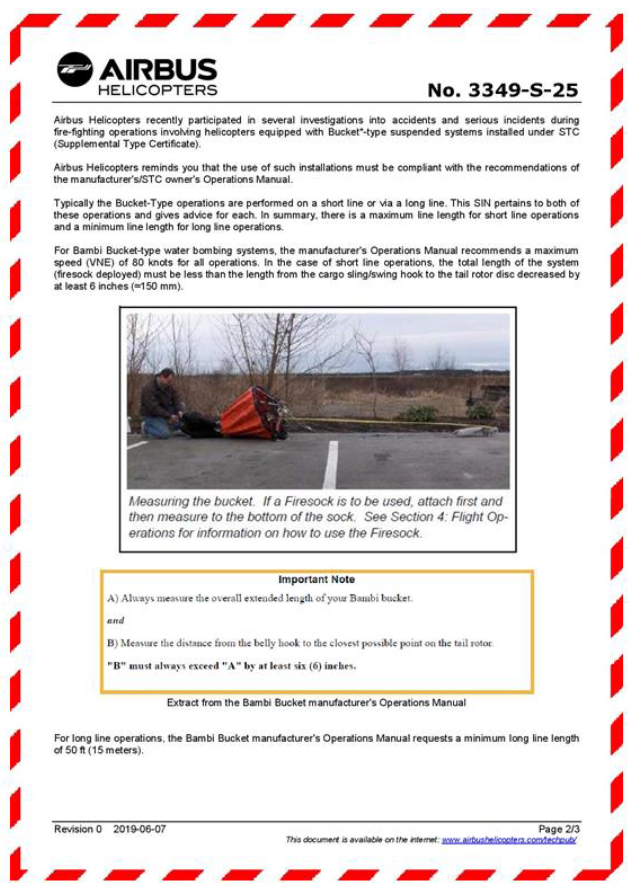
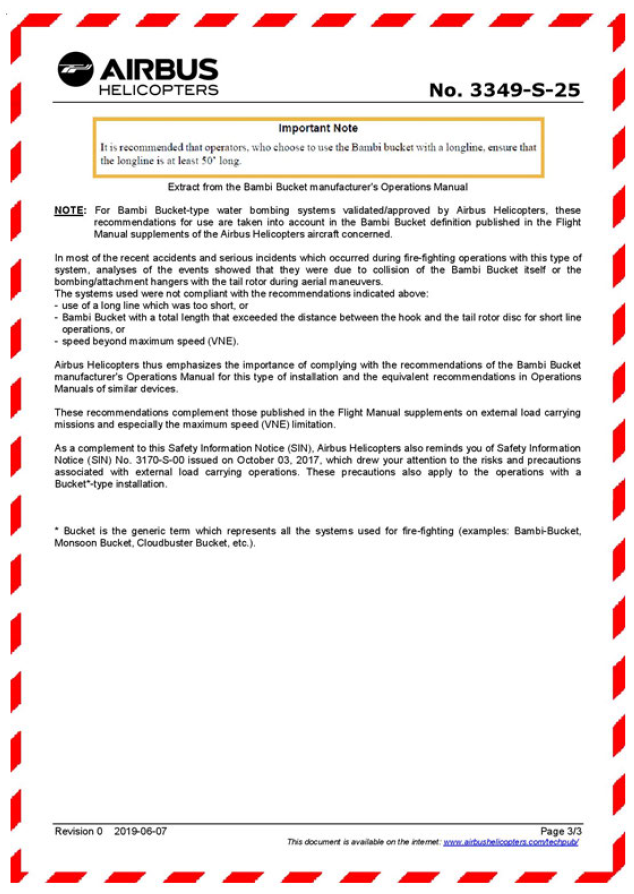
Appendix 4. IMS New Zealand Limited Safety Information Letter 6 April 2020
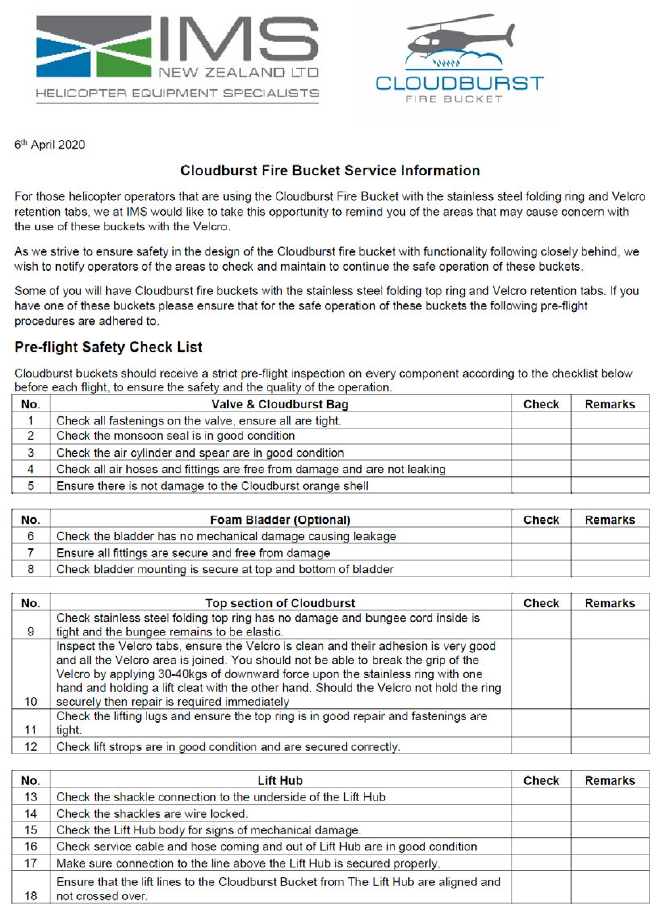
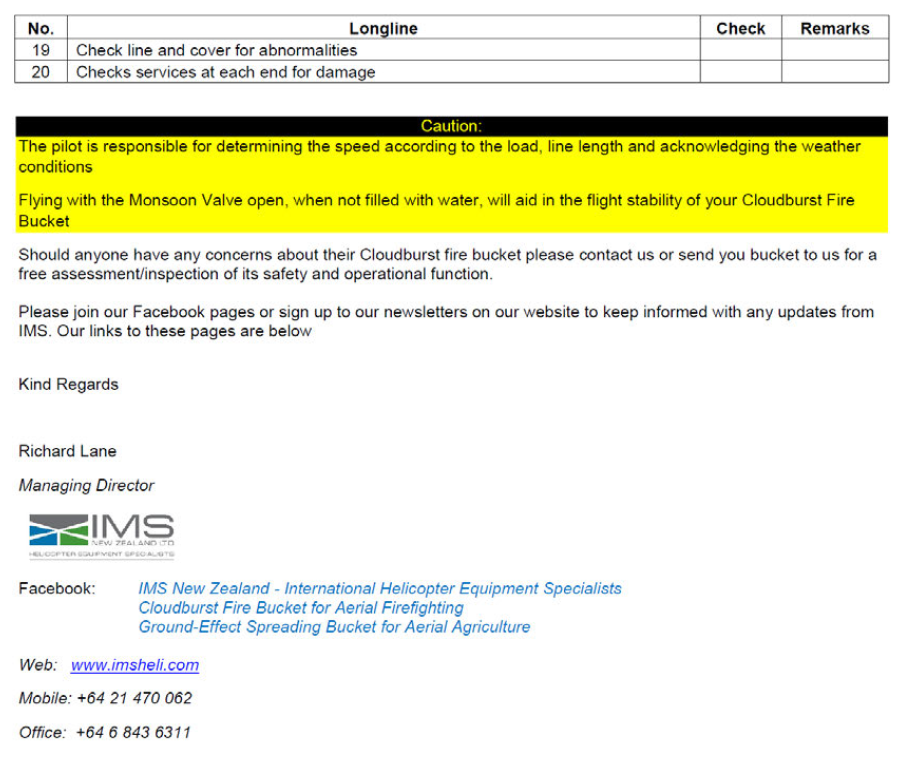
Appendix 5. IMS New Zealand Limited Safety Information Notice 3 July 2020

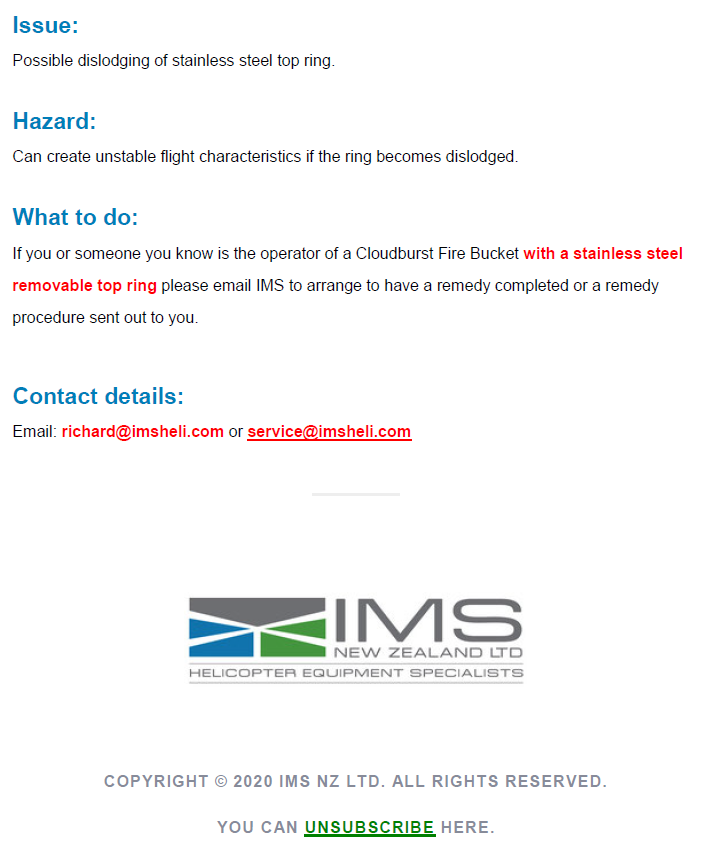
Related Recommendations
On 25 June 2020 the Commission recommended that IMS New Zealand Limited review and enhance the Operation Manuals for all Cloudburst buckets to include any recommended operational and maintenance procedures, guidelines and limitations, and develop a current register of users and actively disseminate this information to them.
On 25 June 2020 the Commission recommended that the Managing Director of IMS New Zealand ensure that all Cloudburst monsoon buckets with hook-and-loop fasteners are modified to incorporate improvements in the fastener design.
